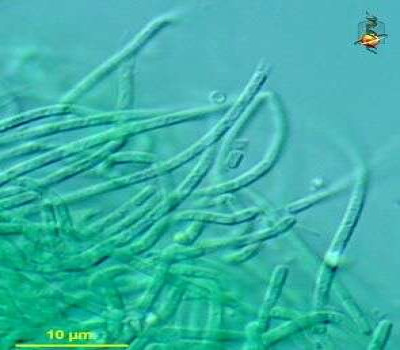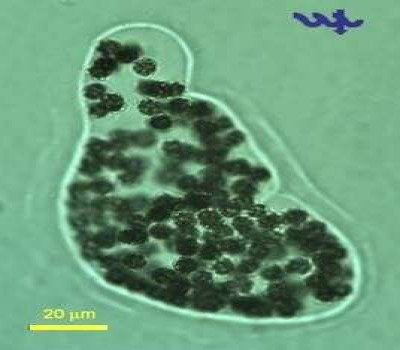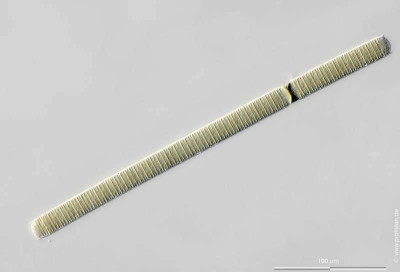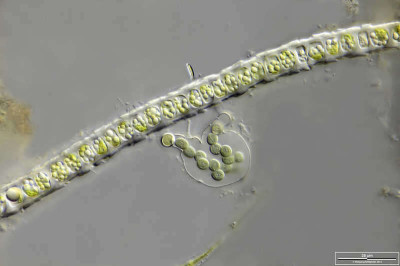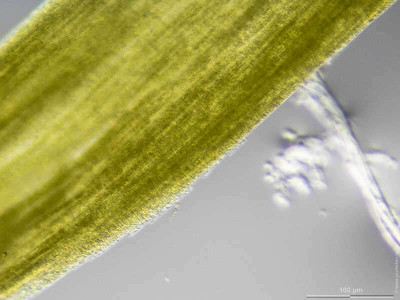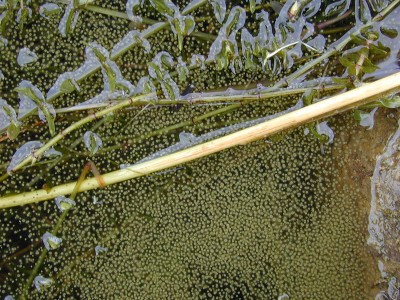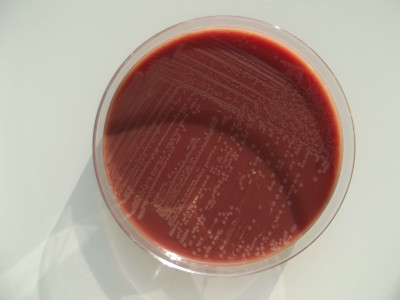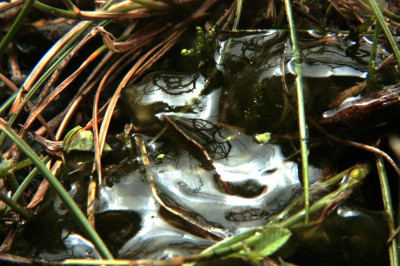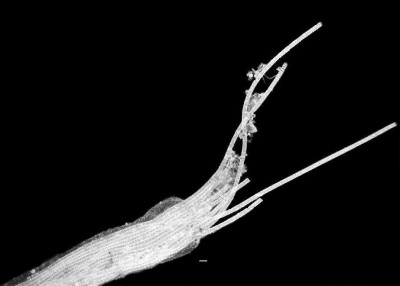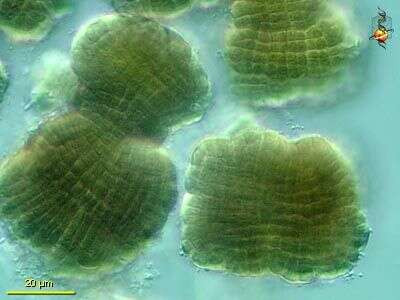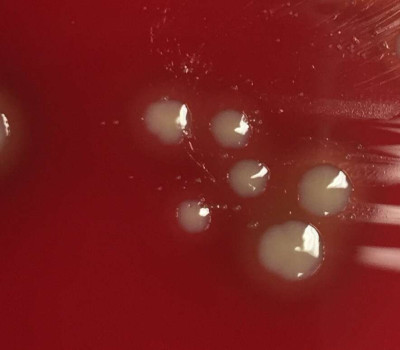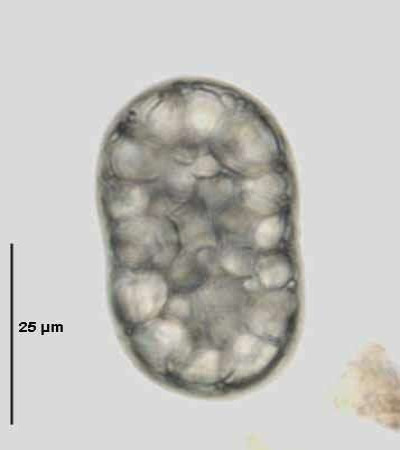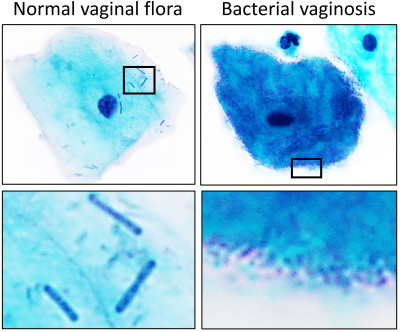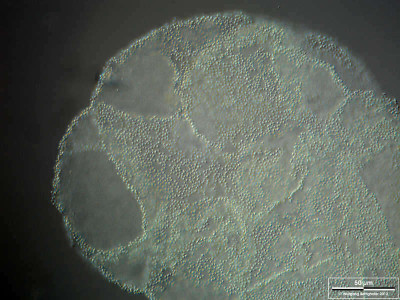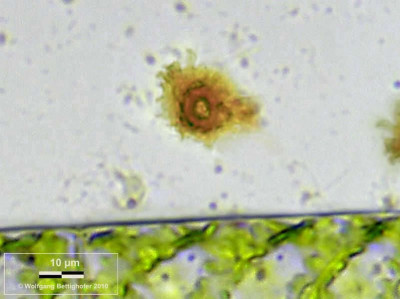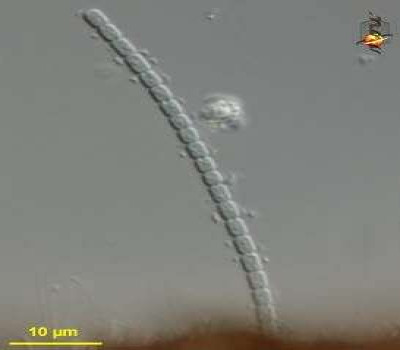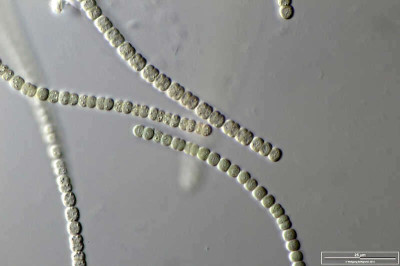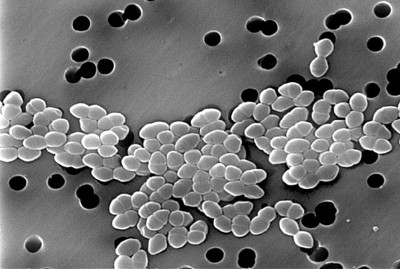Phormidium (four-mid-ee-um) a filamentous blue-green alga with the filaments enclosed within an organic sheath. Differential interference microscopy.
David Patterson and Bob Andersen, micro*scope
29 Jul 2024
Of the genus Microcystis (Cyanobacteria, chroococales), M. wesenbergii is the easiest species to identify: the spherical cells are relatively large (5-8 µm) and are embedded in thick colorless homogeneous mucilage with clearly defined contours. It is generally less abundant in Lake Kinneret than M. aeruginosa and M. flos aquae.
Alla Alster; Tamar Zohary, micro*scope
31 Jul 2024
Oscillatoria limosa The scale bar indicates 100 µm. Sample from the Domänental pond near Kronshagen (Kiel, Germany). Images were taken using Zeiss Axioplan with Olympus OM-D M5 MKII.
Wolfgang Bettighofer, protisten.de
01 Aug 2024
Nostoc sphaericum Scale bar indicates 25 µm. Sample from the wetland at Mittermoos near Pillersee (Tyrol, Austria). The image was built up using several photomicrographic frames with manual stacking technique. Images were taken using Zeiss Universal with Canon EOS 600D.
Wolfgang Bettighofer, protisten.de
01 Aug 2024
Aphanizomenon flos-aquae Scale bar indicates 100 µm. Sample from the wetland Seekamper Seewiesen in Schilksee (Kiel). Sampling date 8/2021. Images were taken using Olympus stereomicroscope SZX16 with Olympus OM-D M5 MKII.
Wolfgang Bettighofer, protisten.de
01 Aug 2024
Longitude (deg): -2.1. Latitude (deg): 54.0. Longitude (deg/min): 2° 10' W. Latitude (deg/min): 54° 10' N. Vice county name: Mid-west Yorks. Vice county no.: 64. Country: England. Identified by: Malcolm Storey. Comment: dense bloom in water. Category: standard photograph or close-up. Where photo was taken: In situ. Photographic equipment used: Nikon Coolpix 950.
Malcolm Storey, BioImages, the virtual fieldguide, UK
08 Aug 2024
Cultivate on PVX chocolate agar. Date: May 29, 2016 at 13:20:12.
Manurx27, Wikimedia Commons
24 Jul 2024
Nostoc commune Nostoc mucilage in the grass roots after a rainy day. Sample from my garden in Kiel (Schleswig-Holstein, Germany). Images were taken using Zeiss Axioplan with Canon 600D.
Wolfgang Bettighofer, protisten.de
02 Aug 2024
Thioploca is a genus of bacteria that are known for their unique lifestyle and morphology. They are notable for forming long, thread-like chains of cells that can reach several centimeters in length. These bacteria are found in marine environments, particularly in oxygen-deficient sediments rich in hydrogen sulfide.
This beautiful picture taken by Carola Espinoza shows a bundle of sheathed Thioploca chileae. The polysacharide sheath is seen as a transparent sleeve. This allows Thioploca trichomes to slide up and down within the sediment which allows the organism to obtain nitrate from the overlying water and hydrogen sulfide from the depths of the sediment layer. The bar depicts 10 micrometers.
giantbacteria, Flickr Group
22 Jul 2024
Chroococcidiopsis (crow-owe-cock-id-ee-op-sis) polanisana, a blue green alga (cyanobacterium) with aggregated cells forming a sheet-like array. Blue green or olive green in colour. Differential interference microscopy.
David Patterson, Bob Andersen, micro*scope
22 Jul 2024
Anacystis (a-na-cyst-is) is a cyanobacterium in which globular cells are located within a gelatinous matrix. Some of the cyanobacteria with this form can be toxic. Differential interference contrast.
Linda Amaral Zettler, David Patterson, micro*scope
23 Jul 2024
Description: English: Haemophilus influenzae satelliting colonies (pin point) near Staphylococcus aureus (yellow) on blood agar plate. Date: 6 February 2016. Camera location32° 44′ 08.5″ N, 97° 20′ 27.2″ W View all coordinates using: OpenStreetMap 32.735694; -97.340889.
Deminorwood, Wikimedia Commons
24 Jul 2024
Achromatium oxaliferum (Schewiakoff 1893), a large colorless sulpher bacterium from bottom sediments of a stagnant freshwater pond near Boise, Idaho. DIC.
William Bourland, micro*scope
24 Jul 2024
Vaginal squamous cell with normal vaginal flora versus bacterial vaginosis on Pap stain. Normal vaginal flora (left) is predominantly rod-shaped Lactobacilli whereas in bacterial vaginosis (right) there is an overgrowth of bacteria which can be of multiple species. Date: 10 September 2022.
Mikael Häggström, M.D. Author info - Reusing images- Conflicts of interest: None Mikael Häggström, M.D.Consent note: Consent from the patient or patient's relatives is regarded as redundant, because of absence of identifiable features, Wikimedia Commons
24 Jul 2024
Chroococcus turgidus High resolution photo of Chroococcus turgidus using Planapo 63/1.4. Sample from sphagnum pond situated in the northern alpine region of Austria near Salzburg. Images were taken using Zeiss Universal with Olympus C7070 CCD camera.Image under Creative Commons License V 3.0 (CC BY-NC-SA). Place name: Bogs near Salzburg (Austria) Latitude: 48.068516 Longitude: 12.954134 Bild in hoher Auflösung von Chroococcus turgidus. Probe aus einem Moor in den nördlichen Kalkalpen von Österreich in der Nähe von Salzburg. Mikrotechnik: Zeiss Universal, Kamera: Olympus C7070. Creative Commons License V 3.0 (CC BY-NC-SA). For permission to use of (high-resolution) images please contact postmaster@protisten.de.
Wolfgang Bettighofer, protisten.de
29 Jul 2024
Pelodictyon luteolum is a photoautotrophic bacterium living in the upper anaerobic zone in waters. Scale bar indicates 25 µm. Collected in the wetlands of national park Unteres Odertal (100 km north east of Berlin). The image was built up using several photomicrographic frames with manual stacking technique. Images were taken using Zeiss Universal with Olympus C7070 CCD camera.
Wolfgang Bettighofer, protisten.de
30 Jul 2024
Siderocapsa species. Siderocapsa belongs to iron bacteria. Every colony of Siderocapsa cells build a brown gelatinous annulus which give shelter. They gain energy by oxidizing dissolved ferrous iron or/and manganese. The metabolite ferric oxide is insoluble, and appears as brown deposit in the gelatinous slime. Sample from a little creek near Kiel. This image was taken using Zeiss Universal with Olympus C7070 CCD camera.
Wolfgang Bettighofer, protisten.de
30 Jul 2024
Filamentous cyanobacterium, unidentified, found as one of several cyanobacterial epibionts on the leaves of the moss Hygrohypnum, a site which seems to be a focus for nitrogen fixation. Differential interference contrast.
Michele Bahr and David Patterson, micro*scope
02 Aug 2024
Nostoc commune Scale bar indicates 10 µm. Sample from my garden in Kiel (Schleswig-Holstein, Germany). Images were taken using Zeiss Axioplan with Canon 600D.
Wolfgang Bettighofer, protisten.de
02 Aug 2024
Scanning Electron Micrograph of Vancomycin Resistant Enterococci.
PHIL, Wikimedia Commons
08 Aug 2024
 Encyclopedia
Encyclopedia
